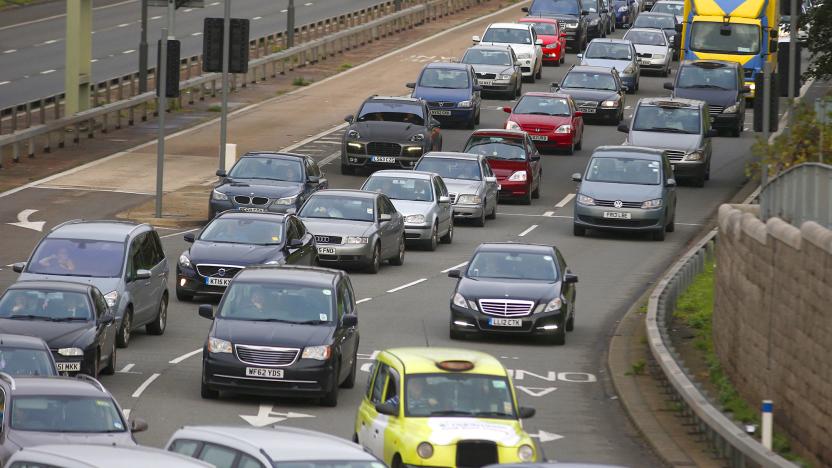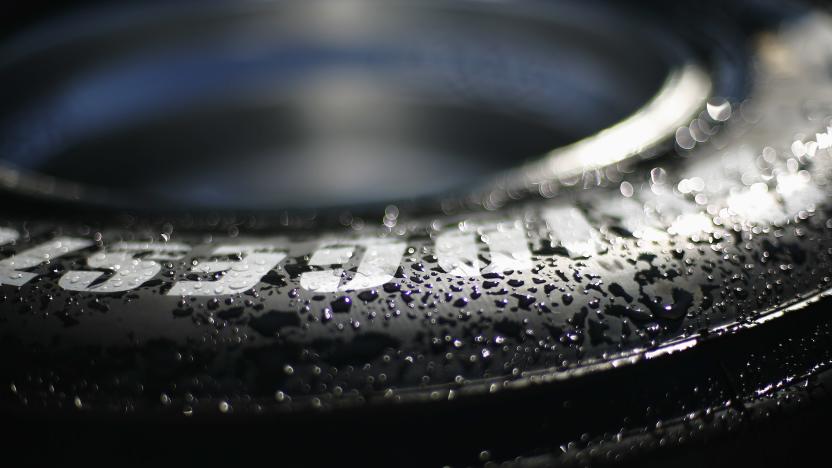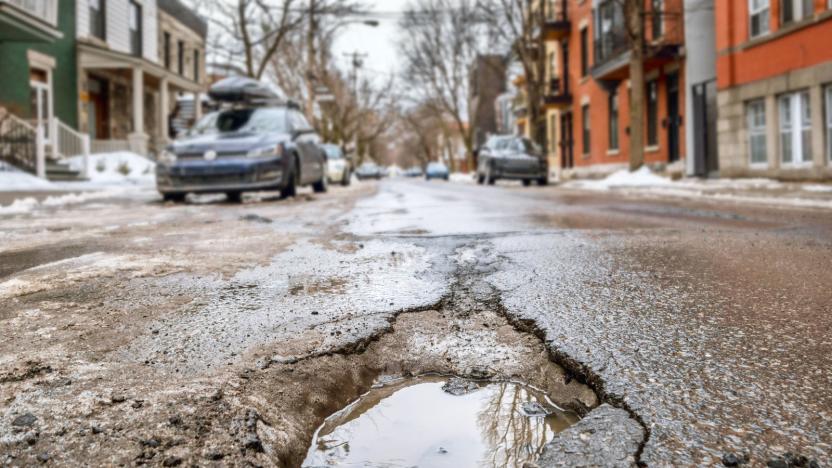roads
Latest

Google's AI stoplight program is now calming traffic in a dozen cities worldwide
Google built an AI that monitors the amount of idling at intersections to help city planners cut congestion and reduce air pollution. Now it's working in 70 intersections.

UK says 'self-driving' cars could be allowed by the end of 2021
The UK government has announced that basic self-driving cars with automated lane-keeping system (ALKS) could arrive on British roads by the end of 2021.

Microsoft and Bridgestone launch real-time tire damage system
A new system can detect tire damage in real time.

Canada launches fund to guarantee faster broadband in rural areas
Canada's CRTC set an aggressive target for the minimum definition of broadband in rural areas, but now appears to have backed off a bit, at least to start. With the launch of the $750 million Broadband Fund, it has set the minimum speed at 25 Mbps download and 5 Mbps uploads, exactly half the speed target of 50/10 Mbps it set earlier. The regulator said that the revised goals would "result in projects covering underserved areas that would deliver a broadband Internet access service that the majority of Canadians use today."

Self-repairing roads could also charge your electric car
Potholes are bad enough for the jarring rides, car damage and safety hazards they create, but it's also problematic to fix them. You're looking at lane and road closures that can last for days, assuming the city can even spare the resources. However, Dutch researchers might have a solution that not only helps the road fix itself, but promises to solve range anxiety for electric car drivers. Delft University's Erik Schlangen tells The Verge that there are plans to test self-repairing asphalt whose conductive steel fibers and bacteria would both fix small cracks in the pavement and send electricity to EVs above. The trial will charge your vehicles when you're stopped at intersections, giving you a little bit of extra range in those moments you're waiting for the light to turn green.

Canada sets aggressive targets for minimum broadband speeds
Canadian regulators have declared that all citizens should have access to high-speed internet, even in remote areas. The Canadian Radio-television and Telecommunications Commission (CRTC) has ruled that minimum broadband speeds of 50 Mbps download and 10 Mbps upload speeds are now a "basic telecommunications service." Furthermore, it said all customers should have unlimited data options and not be capped, as they often are in rural areas.

UK to introduce new road laws allowing the use of self-driving cars
Not to be left behind by developments in the US, the UK government is set to rewrite road laws to allow self-driving cars on Britain's roads. According to Mail Online, science minister David Willetts has already opened discussions with the Department for Transport to help British companies develop their own driverless cars and encourage the world's car companies to do the same. Willetts' comments come just weeks after Google showed off its new self-driving prototypes that don't come equipped with a steering wheel, mirrors or pedals. As we've noted before, laws covering driverless cars are still new, with only a few US states, including California, Nevada, Michigan, Florida and the District of Columbia, giving them the green light (but require someone to sit in the passenger seat, at least for now). The UK government aims to follow suit, allowing researchers at Oxford University, who have pioneered a cheaper version of Google's self-driving tech, to legally test different driving scenarios on (hopefully quiet) British roads.

Those glow-in-the-dark roads? They didn't fare well in the first public trials
The pilot project that looks to replace streetlights with video game-esque glow-in-the-dark lane markers in the Netherlands has hit a bit of a snag. If you're in need of a refresher, the lines absorb ultraviolet light during the day before glowing through the night. So far, performance has been less than consistent. The markers don't give off a uniform amount of light, and more importantly, they've been disappearing with heavy rainfall. In a press release earlier this week, Dutch engineering firm Heijmans Infrastructure said that it'll address the issues for the next iteration that's slated for more widespread testing this summer, pressing pause until then. "We will use these insights to introduce an update to the Glowing Lines 2.0 version. In the meantime we have temporarily faded out the lining to prevent any confusing situations for road users," the statement read.

Japanese group transmits electricity through 4-inch concrete block, could power cars on roads
The decision to invest in an electric vehicle would be much easier to justify if the car in question offered unlimited range. That appears to be the concept behind a Toyohashi University research group's wireless power prototype, which can successfully transmit electricity through a 10 centimeter-thick concrete block. During a demonstration in Yokohama, Japan, the team sent between 50 and 60 watts of power through a pair of concrete blocks to two tires, which then juiced up a light bulb (you can see the rig just above). The project is called EVER (Electric Vehicle on Electrified Roadway), and could someday be used to keep cars moving along a highway without any need to pull over for a recharge, thanks to a constant stream of electricity coming from below the road. There are some serious obstacles to overcome before EVER can get some wheels turning -- namely, a need to pump nearly 100 times the current maximum load through concrete that's twice as thick as what they've managed today, not to mention improving undisclosed efficiency levels -- but the group reportedly said that it's up to the task, making us fairly optimistic that such a solution could one day get us from A to B without petrol. Until then, you'll probably want to plan out a pit stop or two before you leave the garage.

Proposal would put a solar garden on the Brooklyn-Queens Expressway
If you've ever spent any time on New York City's finest roadway, the Brooklyn Queens Expressway, garden is not one of the first words that comes to mind. That could change on one particular strip in Brooklyn if a concept -- which you see above -- gets approved and built. The concept is part of a project calling for solutions to a trench that runs from Carroll Gardens to the Columbia Street Waterfront in Brooklyn. Starr Whitehouse Landscape architects floated three possible solutions for improving the stretch, which would cost between about $10 and $18 million, very cheap in comparison to other projects of this type. The Green Canopy proposal calls for a massive plant covered canopy with solar panels to stretch over top of the entire area making it self-sustaining and reducing noise in the area. Hit up the source to check out the other proposed projects.

MotionPower speed bump installed at NJ Burger King, McDonald's and Wendy's feel slighted
We can't say we doubted that New Energy's MotionPower speed bump would actually be installed at a New Jersey Burger King, but it's always refreshing to see a plan morph into reality. As of now, those in Hillside heading to have it their way will cruise over the kinetic energy harvester before retrieving their grub, which has the potential to create around 2,000 watts of electricity from a car hitting it at five miles per hour. As of now, the hump is simply there to test storage potential, but New Energy is hoping that the next generation of the tech could be placed at a variety of fast foot eateries, parking lots, toll booth plazas and anywhere else where folks need a little assistance in maintaining a sensible speed. Check out the read link for a plethora of shots, and feel free to splurge on a #4 combo today if you're in the area -- Ma Earth will thank you.

Changes to old Azeroth coming in the next expansion
In the last expansion, all we did was walk through a portal and find a new world -- the old one was left pretty much unchanged overall. But in this coming expansion, Blizzard has made it pretty clear that almost nothing is off limits -- Northrend is getting added to Azeroth, and we're not traveling across space to get there. And considering that Arthas' story echoes throughout almost all of the old world (and that the whole thing is named after him), things are definitely going to change once Northrend appears on the world map.So we've put together a gallery of just what will be different about the old world after the Wrath of the Lich King comes upon us. To be fair, some are set in stone (we know for sure that Naxxaramas is exiting stage left for a bigger part later), and some are little more than speculation (Uther played a huge part in Arthas' life, so his tomb seems like a good stage for an event at some point), but odds are that by the time we've all reached level 80, all of these places in Old Azeroth will look very different.%Gallery-25018%

France's Eurovia aims to make roads change color to warn of ice
While there's already GPS systems out there that'll give drivers some indication of road conditions, French company Eurovia is aiming to provide some warnings that are decidedly more real-time, with it now testing a process that'll actually change the color of roads as the temperature dips into freezing territory. That's, of course, not an entirely new process (we've already seen spoons that change color based on temperature), but Eurovia is apparently fine tuning things to hold up to the wear and tear it'll see on roads, and working to ensure that it turns color early enough so the salt trucks can be deployed before the roads get too dicey. While there's no word as to when we might see a wide-scale deployment, the company did test it with five patches over a 50 kilometer stretch of road in France this winter, and it sees no shortage of benefits to the technology in the future, adding that it could also be used to warn pedestrians to watch their steps on sidewalks.[Via Autoblog]

IBM researching intelligent, reflexive vehicles
Count IBM in as one of the many companies looking to skyrocket the cost of our future cars, er, protect our lives by developing must-have active safety systems that are sure to become the standard fare in vehicles of the future. Dubbed a research initiative to "equip cars with technologies that can help reduce traffic congestion and prevent accidents," IBM is looking into driver assist technologies that "exchange information with other cars and with the road infrastructure, take corrective action where appropriate, and provide essential feedback to the drivers to help avoid dangerous situations." These electronic reflexes are said to be much quicker than those possessed by humans, and while the team is not trying to replace the need for driver judgment entirely, it is hoping to provide adequate feedback to help the motorist avoid potential perils. No word on when IBM plans on ushering its marketing team into automakers' headquarters, but we'd enjoy the feel of personally steering and accelerating while you still can.[Via Physorg]

Thieves swiping HOV exemption stickers from hybrids
For those of you enjoying the free-flowing high-occupancy vehicle lane on the Capitol Expressway (in your HOV-exempt hybrid, no less), stay sharp, as it looks like those oh-so-valuable stickers that reside on your ride appear as gold to thieves. Apparently, "two to three dozen" victims per month are surfacing in California, where the now-extinct stickers are presumably fetching a pretty penny on the underground markets. The labels -- which were handed out to some 85,000 hybrid owners in years past to give them the same speedy privileges are carpoolers -- are no longer being administered by the DMV, which means that those that were able to take advantage are now targets. Interestingly, hybrid vehicles that are up for sale in the area are fetching "nearly $4,000 more" than comparative models so long as they come with the coveted sticker pre-installed. Notably, the DMV claims that the "carpool stickers are treated chemically so they crumble apart if tampered with," but that wee tidbit isn't likely to slow down a desperate bandit.[Via Fark]








